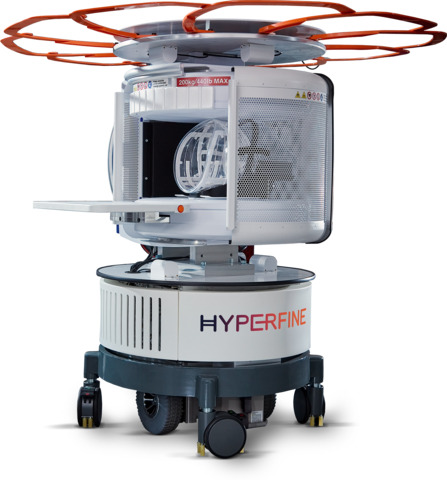Study will assess the clinical utility and workflow benefits of physicians using images acquired by the Swoop® Portable MR Imaging® system to identify ARIA events in Alzheimer’s patients treated with amyloid-targeting therapy
Hyperfine, Inc. (Nasdaq: HYPR), the groundbreaking health technology company that has redefined brain imaging with the first FDA-cleared portable magnetic resonance (MR) brain imaging system—the Swoop® system—today announced that the first patients have been enrolled in the CARE PMR (Capturing ARIA Risk Equitably with Portable MR) observational study. The study is designed to assess the clinical utility and workflow benefits of Swoop® system images acquired at infusion centers and clinics to help physicians detect amyloid-related imaging abnormalities (ARIA) in Alzheimer’s patients receiving amyloid-targeting therapy at the times specified in the labeling (before the fifth, seventh, and fourteenth infusions).
This press release features multimedia. View the full release here: https://www.businesswire.com/news/home/20240417265912/en/

Hyperfine, Inc. Swoop�� system (Photo: Business Wire)
Alzheimer’s disease is the most common form of dementia worldwide, affecting more than six million people in the U.S. alone1. Patients with Alzheimer’s can now be treated with amyloid-targeting therapy, which reduces the amyloid plaque burden in the brain. Potential side effects for patients using amyloid-targeting therapy exist, including ARIA, and patients are required to receive multiple MRI brain scans during their first year of treatment as included in the FDA-approved labeling for the medication.
“We’ll be evaluating whether portable MR brain imaging can reliably identify brain swelling and bleeding, which have been associated with amyloid-targeting therapies,” said Dr. Tammie Benzinger, professor of radiology and neurological surgery at the Washington School of Medicine and primary investigator of CARE PMR. “This information can help determine whether portable MR imaging—offered at the same time as anti-amyloid infusions—could lessen the inconvenience for patients.”
Mass General Brigham has also begun scanning Alzheimer’s patients with the Swoop® system to obtain longitudinal data as well as enroll patients in the CARE PMR protocol to screen for ARIA events. This work, led by Drs. Teresa Gomez-Isla and W. Taylor Kimberly, will evaluate the Swoop® system to understand its potential role in the overall continuum of Alzheimer’s care.
“The newly approved amyloid-targeting therapy represents a major milestone in the global fight against Alzheimer’s, bringing hope of additional years of independent living to patients. The required MRI scans to image brain abnormalities in patients receiving amyloid-targeting therapy present workflow challenges for patients and providers,” said Hyperfine, Inc. President and CEO Maria Sainz. “Patients can be safely scanned with the Swoop® system wherever in a healthcare setting is most convenient, and we believe that it greatly simplifies the workflow and provides significant benefits in care efficiency and cost. We look forward to investigating its potential as a screening tool and exploring how this accessible and affordable portable MRI modality can help address the challenges of access to care and equity challenges intrinsic to new treatments for this devastating global disease.”
The Swoop® system is a portable, AI-powered, ultra-low-field MR brain imaging system designed to be available when and where physicians need it, potentially allowing for timelier treatment decisions. Brain images acquired with the Swoop® system can help physicians diagnose a variety of neurological conditions without the delays, costs, and inconvenience of a conventional high-field MRI scan.
For more information about the Swoop® Portable MR Imaging® system, please visit hyperfine.io.
About the Swoop® Portable MR Imaging® System
The Swoop® Portable MR Imaging® system is U.S. Food and Drug Administration (FDA) cleared and has been approved for brain imaging of patients of all ages. It is a portable, ultra-low-field magnetic resonance imaging device for producing images that display the internal structure of the head where full diagnostic examination is not clinically practical. When interpreted by a trained physician, these images provide information that can be useful in determining a diagnosis. The Swoop® system also has CE certification in the European Union and UKCA certification in the United Kingdom. The Swoop® system is commercially available in a select number of international markets.
About Hyperfine, Inc.
Hyperfine, Inc. (Nasdaq: HYPR) is the groundbreaking health technology company that has redefined brain imaging with the Swoop® system—the first FDA-cleared, portable, ultra-low-field, magnetic resonance brain imaging system capable of providing imaging at multiple points of care. The mission of Hyperfine, Inc. is to revolutionize patient care globally through transformational, accessible, clinically relevant diagnostic imaging. Founded by Dr. Jonathan Rothberg in a technology-based incubator called 4Catalyzer, Hyperfine, Inc. scientists, engineers, and physicists developed the Swoop® system out of a passion for redefining brain imaging methodology and how clinicians can apply accessible diagnostic imaging to patient care. For more information, visit hyperfine.io.
Hyperfine, Swoop, and Portable MR Imaging are registered trademarks of Hyperfine, Inc.
Forward-Looking Statements
This press release includes “forward-looking statements” within the meaning of the “safe harbor” provisions of the Private Securities Litigation Reform Act of 1995. Actual results of Hyperfine, Inc. (the “Company”) may differ from its expectations, estimates and projections and consequently, you should not rely on these forward-looking statements as predictions of future events. Words such as “expect,” “estimate,” “project,” “budget,” “forecast,” “anticipate,” “intend,” “plan,” “may,” “will,” “could,” “should,” “believes,” “predicts,” “potential,” “continue,” and similar expressions (or the negative versions of such words or expressions) are intended to identify such forward-looking statements. These forward-looking statements include, without limitation, the Company’s goals and commercial plans, the benefits of the Company’s products and services, and the Company’s future performance and its ability to implement its strategy. These forward-looking statements involve significant risks and uncertainties that could cause the actual results to differ materially from the expected results. Most of these factors are outside of the Company’s control and are difficult to predict. Factors that may cause such differences include, but are not limited to: the success, cost and timing of the Company’s product development and commercialization activities, including the degree that the Swoop® system is accepted and used by healthcare professionals; the impact of COVID-19 on the Company’s business; the inability to maintain the listing of the Company’s Class A common stock on the Nasdaq; the Company’s inability to grow and manage growth profitably and retain its key employees; changes in applicable laws or regulations; the inability of the Company to raise financing in the future; the inability of the Company to obtain and maintain regulatory clearance or approval for its products, and any related restrictions and limitations of any cleared or approved product; the inability of the Company to identify, in-license or acquire additional technology; the inability of the Company to maintain its existing or future license, manufacturing, supply and distribution agreements and to obtain adequate supply of its products; the inability of the Company to compete with other companies currently marketing or engaged in the development of products and services that the Company is currently marketing or developing; the size and growth potential of the markets for the Company’s products and services, and its ability to serve those markets, either alone or in partnership with others; the pricing of the Company’s products and services and reimbursement for medical procedures conducted using the Company’s products and services; the Company’s estimates regarding expenses, revenue, capital requirements and needs for additional financing; the Company’s financial performance; and other risks and uncertainties indicated from time to time in Company’s filings with the Securities and Exchange Commission, including those under “Risk Factors” therein. The Company cautions readers that the foregoing list of factors is not exclusive and that readers should not place undue reliance upon any forward-looking statements, which speak only as of the date made. The Company does not undertake or accept any obligation or undertaking to release publicly any updates or revisions to any forward-looking statements to reflect any change in its expectations or any change in events, conditions or circumstances on which any such statement is based.
1 Alzheimer’s disease facts and figures. Alzheimer’s Disease and Dementia. (n.d.). https://www.alz.org/alzheimers-dementia/facts-figures#:~:text=More%20than%206%20million%20Americans%20of%20all%20ages%20have%20Alzheimer’s,are%20age%2075%20or%20older
View source version on businesswire.com: https://www.businesswire.com/news/home/20240417265912/en/
Contacts
Media Contact
Shay Smith
Health+Commerce
shay@healthandcommerce.com
Investor Contact
Marissa Bych
Gilmartin Group LLC
marissa@gilmartinir.com






